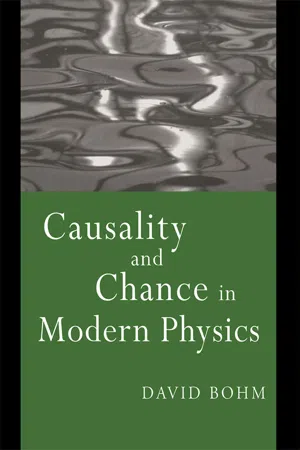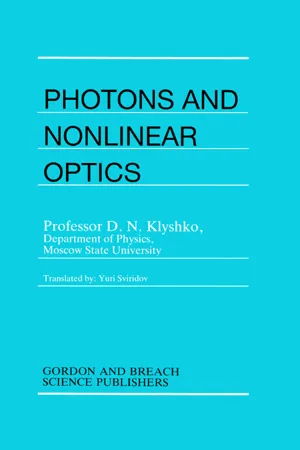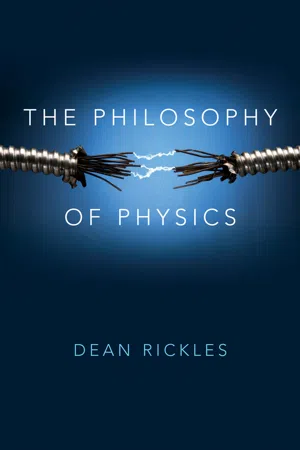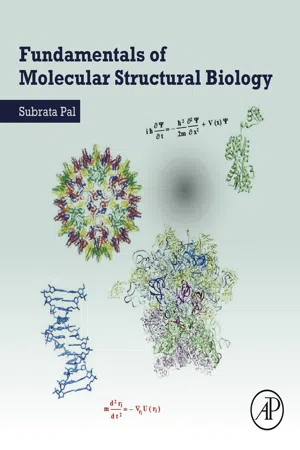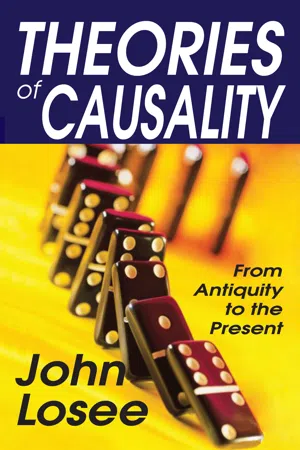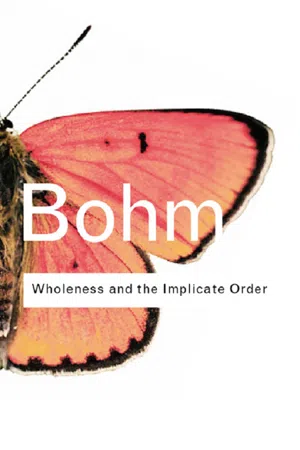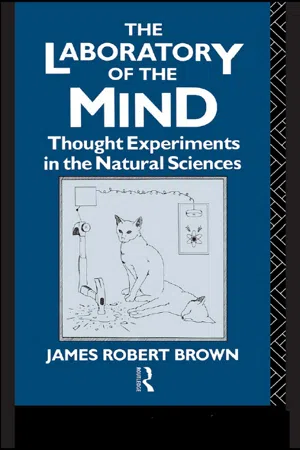Physics
Classical Mechanics vs Quantum Mechanics
Classical mechanics describes the motion of macroscopic objects using Newton's laws of motion and is deterministic in nature. Quantum mechanics, on the other hand, deals with the behavior of particles at the atomic and subatomic levels, where particles can exist in multiple states simultaneously and are described by wave functions. Quantum mechanics introduces uncertainty and probabilistic outcomes, unlike classical mechanics.
Written by Perlego with AI-assistance
8 Key excerpts on "Classical Mechanics vs Quantum Mechanics"
Learn about this page
Index pages curate the most relevant extracts from our library of academic textbooks. They’ve been created using an in-house natural language model (NLM), each adding context and meaning to key research topics.
- eBook - ePub
- David Bohm(Author)
- 2004(Publication Date)
- Routledge(Publisher)
2. CLASSICAL MECHANICS
The most important developments in physics between the sixteenth and the nineteenth centuries were founded on a certain body of very general, very comprehensive, and very precisely expressed theory usually referred to as classical mechanics , which concerns itself primarily with the laws governing the motions of bodies through space. Now in the earlier stages of their development (as in the times of the ancient Greeks), the laws of mechanics had generally been given a vague and qualitative form.* With the work of Galileo and others, however, the tendency to express the laws of physics (and to some extent of chemistry and other sciences) in a precise quantitative form began to assume a very great importance. This trend towards quantitative precision in the expression of physical law continued to grow, and first reached its full development with Newton’s laws of motion. These laws, which state that the acceleration of a body is directly proportional to the force acting on it and inversely proportional to its mass, are expressed mathematically by means of the differential equation, where x→ is the position vector of the body, F→ the force acting on it, and m is its mass.Newton’s laws of motion imply that the future behaviour of a system of bodies is determined completely and precisely for all time in terms of the initial positions and velocities of all the bodies at a given instant of time, and of the forces acting on the bodies. These forces may be external forces , which arise outside the system under investigation, or they may be internal forces of interaction between the various bodies that make up the system in question.In many problems the external forces are small enough to be neglected (i.e. the system may be regarded as isolated), while the internal forces can be represented solely in terms of functions of the positions and velocities of the centres of mass of the bodies. This approximation is particularly good in the problem of the motion of the planets around the sun. In such a case, Newton’s laws determine the future motions of the bodies in terms of nothing more than the positions and velocities of the bodies at a given instant of time. Thus, they constitute a set of “one-to-one” causal relationships, of the type described in Chapter I , Section 7 - eBook - ePub
- D.N. Klyshko(Author)
- 2018(Publication Date)
- Routledge(Publisher)
2 Some Information on Quantum Mechanics and Statistical PhysicsTHIS CHAPTER provides a brief summary of some of the basic concepts and formal rules used in quantum mechanics and statistics that we shall need later to describe the radiation of light and its scattering by matter. Section 2.1 contains a recipe for passing from the classical equations of motion to quantum equations. It also discusses the relation between observed and calculated quantities. Section 2.2 introduces the convenient Dirac notation and a geometric interpretation of quantum mechanics. Section 2.3 examines the interaction representation and the theory of perturbation. Section 2.4 deals with an important law of statistical physics known as the fluctuation-dissipation theorem (FDT). Finally, Section 2.5 introduces the notions of relaxation and the thermostat and derives the simplest kinetic equation, which differs from dynamic equations in that it allows for an interaction with the thermostat. This interaction leads to damping and thermal noises, which are added to the quantum noises when T ≠ 0.2.1 Passing from a Classical Description to a Quantum Description The Quantization of the Equations of Motion Let us assume that the classical equations of motion of the system of interest are known to us. For instance, the classical dynamics of a one-dimensional linear oscillator obeys Newton’s second law:
The procedure for passing to quantum dynamics includes the following four basic stages:mq= − k q + F· ·( t ).(1) 1) The choice of the most convenient system of coordinates {qi (t)}, which, together with the velocities{determine the state of the system, i.e., provide complete information on it.( t ) }q i.2) The selection of that Lagrange’s functionLwhich, given the use of the system of Lagrange’s equations(q ,)q ., tdd t−∂ L∂q ˙i= 0 ,∂ L∂q i(2) leads to the initial equations of motion. Thus, it can readily be verified that (1) - eBook - ePub
- Dean Rickles(Author)
- 2016(Publication Date)
- Polity(Publisher)
7 Quantum Philosophy Quantum mechanics is our best theory of the material world. It has been applied successfully to three of the four interactions of nature (electromagnetic, strong, and weak), and work continues apace to apply it to gravitation. Scott Aaronson ([1], p. 110) describes quantum mechanics as not so much a physical theory, but as something falling halfway between a physical theory and a piece of pure mathematics. He uses the analogy of an operating system [OS], where the procedure of making a theory quantum mechanical (i.e. quantizing) amounts to ‘porting’ the application (e.g. Maxwell’s classical theory of electromagnetism) to the OS. One might extend his analogy by thinking of quantum mechanics itself as a significant ‘upgrade’ from classical (Newtonian) mechanics, which proved unable to ‘run’ certain programs. All of our quantum theories are achieved through this porting procedure: one starts off with a known classical theory and then performs some specific modifications to it. 1 Porting an application into the quantum OS brings along with it a whole bunch of curious features that did not appear on the older OS: indeterminacy, matter waves, contextuality, non-individuality, decoherence, entanglement, and more. These features still account for the vast majority of work done within the philosophy of physics, though recent work done on ‘quantum computation’ has altered their flavour somewhat. Other recent work on quantum theory has tended to focus on specific issues of quantum fields, especially the issue of the extent to which the theory contains particles. These more advanced issues must wait until the next, final chapter. For now we focus on the ‘classic’ philosophical problems of quantum mechanics, and get to grips with its basic features. The four core problems we focus on are: the interpretation of probability and uncertainty; the measurement problem; the problem of nonlocality; and the problem of identity - eBook - ePub
- Subrata Pal(Author)
- 2019(Publication Date)
- Academic Press(Publisher)
Chapter 3Physical basis of chemistry
Abstract
Physics has been the chief agent in transforming molecular biology into molecular structural biology. This chapter gives an overview of different areas of physics as a minimum requirement for the experimental and theoretical understanding of biomolecular interactions and dynamics. The layout of the topics is somewhat similar to one that would appear in an exclusive textbook on basic physics—classical mechanics, wave motion, kinetic theory and thermodynamics, and quantum and statistical physics; nevertheless, the presentation here is purely introductory. In each of the topics, mathematical expressions and equations have been judiciously used to deliver some quantitative sense. All such is expected to facilitate meaningful deliberations in the subsequent chapters.Keywords
Classical mechanics; Wave motion; Kinetic theory and thermodynamics; Quantum physics; StatisticsRichard Feynman, Nobel Laureate in Physics in 1965, had said, “there is nothing that living things do that cannot be understood from the point of view that they are made of atoms acting according to the laws of physics.” On the one hand, physics has provided very powerful techniques such as X-ray crystallography, a wide variety of spectroscopy, and electron microscopy to investigate the biological system at the atomic level. At the same time, physics has also placed chemistry on a sound theoretical foundation from where it has been able to characterize complex molecules and unravel intricate molecular mechanisms of life.3.1 Classical mechanics
3.1.1 Matter and motion
Let us begin by considering an object in motion. The simplest object would be a dimensionless particle. At any particular time t , the location of the particle can be denoted by the position vector r :r = xi ˆ+ yj ˆ+ zk ˆ(3.1)wherei ˆ,j ˆ, andk ˆ - eBook - ePub
Beyond the 80/20 Principle
The Science of Success from Game Theory to the Tipping Point
- Richard Koch(Author)
- 2020(Publication Date)
- Nicholas Brealey Publishing(Publisher)
Relativity theory is odd enough, yet it gets weirder. Take a deep breath.Quantum Mechanics (also known as quantum physics or quantum theory) is the jewel in the crown of twentieth-century science, the most majestic triumph of insight and intellect. Quantum theory shows how the universe, at its most fundamental level, really works. Yet it is not a comfortable ride. Even Einstein found quantum theory so strange and subversive that he refused to accept it all, comparing it to ‘the system of delusions of an exceedingly intelligent paranoiac;’ hence his famous—and wrong—observation that ‘God does not play dice with the universe.’So what is quantum physics, and how was it discovered?Niels Bohr and the quantum leap
The great Danish physicist Niels Bohr (1885–1962) first realized, around 1912–13, that Newtonian mechanics could not explain how atoms behave. Ernest Rutherford (1871–1937) had already developed a model of the atom as a miniature solar system with a tiny nucleus of protons and neutrons orbited by even smaller electrons. It was already known that atoms were unstable. Bohr guessed that electrons changed orbit when they radiated light; he therefore identified the emission of a ‘quantum’ with the ‘jump’ of an electron from one orbit to another.According to Bohr’s model, electrons ‘excited’ by a bombardment of energy may leap from one orbit to another (inner or outer) orbit, instantly passing from one position to another, non-adjacent position, without passing physically in between.This led to the hypothesis that when an atom has a choice of states to leap into, it decides entirely at random. A quantum leap (or jump, the term physicists prefer) is the smallest change that can be made, and it happens unpredictably.Over the next two decades, mathematical modeling of the atom led to new and counterintuitive insights. Two of the most important of these are Heisenberg’s uncertainty principle , and Bohr’s principle of complementarity - eBook - ePub
Theories of Causality
From Antiquity to the Present
- John Losee, John Losee(Authors)
- 2017(Publication Date)
- Routledge(Publisher)
Bohr sometimes claimed that the concepts of classical physics are mere refinements of the concepts of everyday language. This is a dubious claim at best. “Inertial motion” (Newton), “tangentially-acting forces” (Oersted), and “electromagnetic induction” (Faraday) are not straightforward generalizations of everyday experience. However, the thesis that operations of measurement must be described in the concepts of classical physics may be defended without presupposing that the concepts of classical physics are mere refinements of the concepts of everyday language.In support of this position, Heisenberg maintained that the Newtonian–Kantian understanding of “space,” “time,” and “causality” is a necessary condition for the very possibility of science.2 Measuring instruments that are set up for the purpose of observing atomic events are sufficiently heavy to allow an account of their positions and momentums in the terms of classical physics. If the purpose of the experiment is to measure spatial coordinates or time, then rigid, massive measuring rods and clocks are required. If the purpose of the experiment is to measure momentums or energies, the measuring instrument must contain a freely moveable part to which the conservation laws may be applied. In either case, the experimental arrangement and the results of observation must be described in the language of classical physics. The Newtonian concepts are necessary for the description of experimental arrangements and results, but they are inappropriate concepts for defining the state of a quantum mechanical system. Heisenberg pointed out thatwhat Kant had not foreseen was that these a priori concepts can be the conditions for science and at the same time can have only a limited range of applicability.3It is the position of Bohr and Heisenberg that the description of experimental arrangements and results in the concepts of classical physics is a necessary condition of knowledge of the quantum domain. They acknowledged, however, that the range of applicability of the classical concepts does not extend to the theoretical level of the quantum theory. The states of quantum mechanical systems cannot be specified by reference to the concepts of classical physics. - eBook - ePub
- David Bohm(Author)
- 2005(Publication Date)
- Routledge(Publisher)
In classical physics, one thinks that only the actual state of a system can be relevant in a given physical situation, and that probability comes in either because we are ignorant of the actual state or because we are averaging over an ensemble of actual states that are distributed over a range of conditions. In quantum theory it has no meaning to discuss the actual state of a system apart from the whole set of experimental conditions which are essential to actualize this state. 7.4 Non-causal correlations (the paradox of Einstein, Podolsky and Rosen) It is an inference from the quantum theory that events that are separated in space and that are without possibility of connection through interaction are correlated, in a way that can be shown to be incapable of a detailed causal explanation, through the propagation of effects at speeds not greater than that of light. 5 Thus, the quantum theory is not compatible with Einstein’s basic approach to relativity, in which it is essential that such correlations be explainable by signals propagated at speeds not faster than that of light. All of these evidently imply a breakdown of the general order of description that had prevailed before the advent of quantum theory. The limits of this ‘pre-quantum’ order are indeed brought out very clearly in terms of the uncertainty relations which are commonly illustrated in terms of Heisenberg’s famous microscope experiment. This experiment will now be discussed here, in a form somewhat different from that used by Heisenberg, in order to bring out certain new points. Our first step is to go into what it means to make a classical measurement of position and momentum. In doing this, we consider the use of an electron microscope, rather than a light microscope. As shown in Figure 5.7, there is in the target an ‘observed particle’ at O, assumed to have initially a known momentum (e.g., it may be at rest, with zero momentum) - eBook - ePub
The Laboratory of the Mind
Thought Experiments in the Natural Sciences
- James Robert Brown(Author)
- 2005(Publication Date)
- Routledge(Publisher)
true, not a mere approximation; trees, tables, and trucks do not go into states of superposition for Bohr.The wave function of a micro-entity collapses, according to Bohr, when it is in the right sort of relation with a macro-object. Thus, an electron goes into an eigenstate of position in the split screen device when one slit is open; a photon goes into a spin eigenstate in, say, the x direction, when it passes through an appropriately oriented polaroid filter. In each case there is the right sort of relation between micro-and macro-object to bring about the collapse of the wave function. Notice that a conscious human observer need not become aware of the results, but the existence of the macroscopic world is required.Though sympathetic with Bohr’s outlook in general, Eugene Wigner (1962) and others could not follow Bohr in his micro/ macro distinction. There is only one physical world, according to Wigner; so if QM is right anywhere, it is right everywhere. Thus the distinction between micro and macro, while epistemologically significant, is ontologically unimportant. Indeed, it is certainly standard practice among physicists to treat everyday objects as though they are correctly described by QM. In almost every text one first learns the de Broglie relation, p=h/λ, and then as an exercise one is asked to compute the wavelength of a truck roaring down the highway. Of course, the moral of the exercise is that the wavelength is very small, even undetectable, but the tacit implication of such cases is unmistakable—QM applies to the big as well as the small.A unified account is naturally very satisfying, but it comes at a cost. It means that the macroscopic devices that are used to measure quantum systems are themselves QM objects, subject to states of superposition. It was this that Schrödinger made so much of in his cat paradox thought experiment that we discussed in the first chapter—the macroscopic cat is in a superposition of living cat and dead cat.
